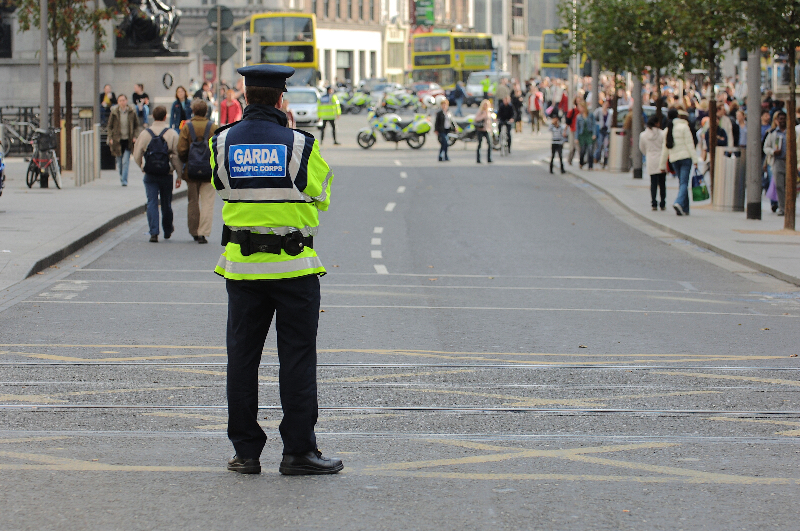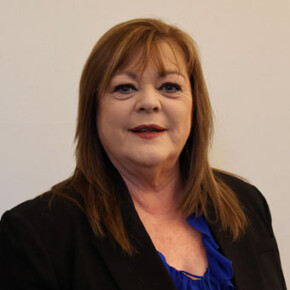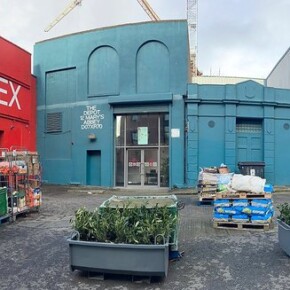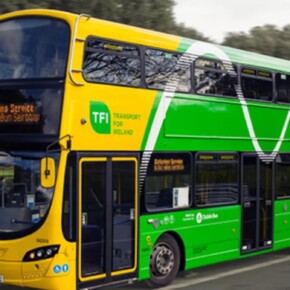The Argentine Republic Emigration Scheme
Dublin People 22 Aug 2024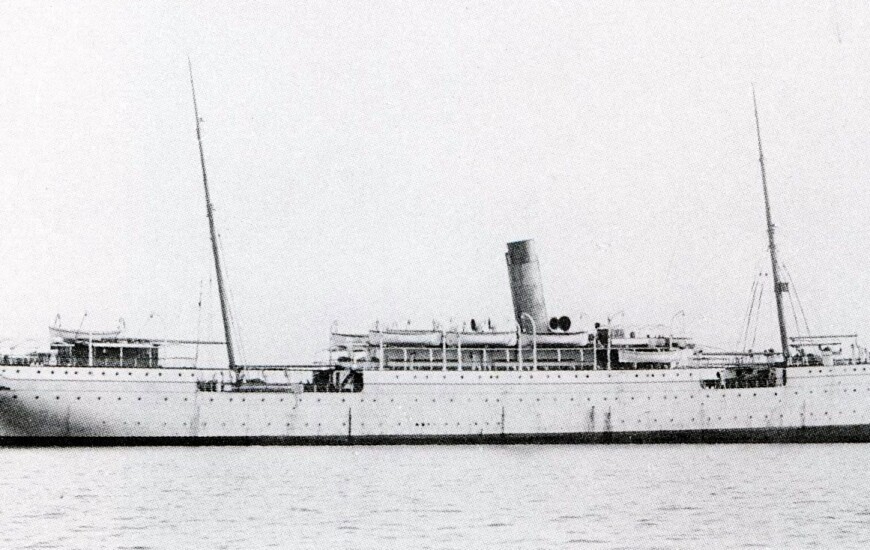
The current anti migrant discourse has inspired the following article from our regular contributor Peter Mulvany.
On Friday January 25, 1889, the SS Dresden left the Deepwater Quay, Queenstown/Cobh, bound for Buenos Aires, with 1772 emigrants onboard 1500 of whom were Irish including the McCarthy family from Ballyclough, County Cork.
The Dreseden subsequently arrived in Buenos Aires on the February 15, 1889, and our family entered Argentina through the immigrants hotel located in the port of Buenos Aires.
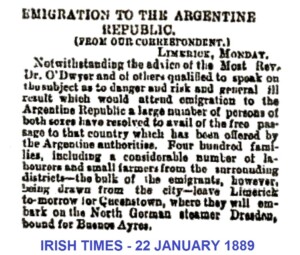
Irish Times Article re Emigration to Argentina: January 22, 1889
The papers of the time reported of the appalling conditions that awaited the Dresden passengers on their arrival at the quayside and but for the English-speaking community of Buenos Aires moving quickly to resolve the problem of overcrowding, many would have died.
On the afternoon of Tuesday, February 26, 1889, approximately ten days after their arrival in Argentina, a large number of the Dresden families were moved south to the new Irish colony set up by Peter Gartland, at La Vitícola, which was then located within the vicinity of Napostá, about 30km North of Bahia Blanca.
Initially living conditions in the settlement were horrendous with little or no housing.
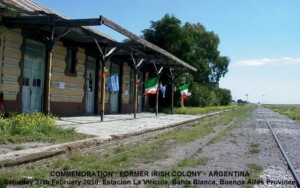
Commemoration 27th February 2010 La Vitícola Railway Station. Picture credit: Peter Mulvany
Families were accommodated in tents with the majority living in the open and many of the youngest children became seriously ill.
A lack of medicines along with their exposure to contaminated water resulted in numerous deaths among the most vulnerable immigrants.
By early 1891 the Irish colony experiment at La Vitícola had failed disastrously, forcing our immigrants to abandon the camp en masse, leaving behind more than a hundred dead most of them Irish children buried in unknown graves and who now rest in eternal silence within the soil of Argentina.
The McCarthy family survived the rigours of living as gauchos on the pampas and later moved to the town of Balcarce, which is approximately 64 Kilometres west of Mar Del Plata.
According to the 1895 Irish-Argentine Census Irlandeses e hiberno-argentinos censados en 1895 en la Provincia de Buenos Aires, TABLA 1V-1, at No 7 – BALCARCE, a) Zona Rural, the McCarthy family head of household is listed as a Tambero [Dairy Farmer]. The McCarthy’s are also listed in Doctor Eduardo Coghlan’s authoritative book on Irish families who had migrated to Argentina.
Patricio (Patrick) McCarthy is one’s grand-uncle and his brother Timoteo (Timothy) McCarthy is my grand-father.
They were both born in Balcarce, Buenos Aires, Argentina in 1897 and 1895 respectively.
Both Timoteo and Patricio were brought to Ireland from Argentina by their widowed Father in 1905 and ended up in the Sacred Heart Home Drumcondra run by the Sisters of Charity.
In 1906 they were sponsored by the St Vincent de Paul Society and sent on to St Vincent’s Orphanage, Glasnevin in Dublin. Spanish was their spoken language at the time.
Later on both went to sea, serving in the catering departments of various national and international shipping lines. Patricio [Patrick] McCarthy had served on the Irish registered fishery protection vessel Fort Rannoch before he lost his life on the Steam Trawler Leukos on the 9th of March of 1940 and is the only Argentine national to have lost his life on an Irish registered vessel during WW2.
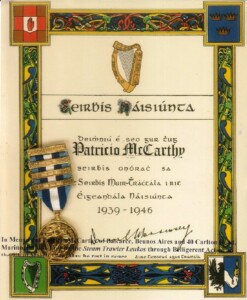
One of the medals awarded to the McCarthys for their serevice to Ireland during the Emergency. Argentine migrants supporting our country in a time of Emergercy.
Timoteo [Timothy] McCarthy served on the Muirchu during 1939 until the handover to the Irish Department of Defence.
He also served with distinction on Irish merchant ships throughout world war two and was a great friend of Captain Henrik Kurt Carlsen of the Flying Enterprise.
Timoteo [Timothy] McCarthy died at sea in August 1960 and is buried in the Cimitero Latino, Rue De Port Said in Alexandria, Egypt.
[The McCarthy family lived in Carlton Road, Marino, during the Emergency 1939-46, and in the late forties relocated to Vernon Drive, Clontarf].
McCarthy Irish Argentine connection.
On Saturday, March 28, 2009, an Air France flight took off from Dublin Airport for Paris bound for Argentina with one Irishman aboard, for a first meeting of the McCarthy family in South America.
As the flight approached Buenos Aires Airport the aircraft route map showed the location of places linked with Irish emigration to the Argentine all those years ago. Sante Fe, Rosario, Mercedes and Mendoza.
Places that one only read about in textbooks and historic journals. It was here in the new rejuvenated quarter of Puerto Modero, some 600 metres from my hotel, that the SS Dresden arrived in January 1889 with the Irish immigrants including my family.
Walking the port area the masthead of the Argentine Tall Ship Libertad could be clearly seen.
She was getting ready for her annual voyage, but this time she is heading to Europe and back to Ireland. On many occasions

I had enjoyed Argentine hospitality on her previous visits to Ireland.
Coming back down the quay Scottish pipes resounded and echoed across the empty space of water of the port.
I instantly recognised the lament. Here were Scottish descendents on a Sunday afternoon proudly showing off their Scottish Argentine heritage.
Not one could speak English, and yet I think they understood that I to was seeking to recover my emigrant history. Irlanda I said.
Orkney Island was the retort. They knew.
Somehow one felt at home in a very distant but unique way.
The next day while motoring down to Mar Del Plata we passed roadside placards advertising O’Keefe Chacos, Campos.
John Bryan, Gannon, Irish names abound. One thought of the many family discussions at home of the flat lands that are the Pampas and the Argentine native cowboy, the Gaucho.
To see for the first time our great-grandparents grave in Balcarce Cemetery is an emotional experience.
One thought of the many occasions I had drawn attention to American visitors to Ireland on their journey of remembrance.
Yet, here I was in the middle of Argentina doing exactly the same.
A very strange but humbling experience.
Times must have been hard, yet they survived. Other members of our family have served in the Argentine government with distinction.
Those Irish who emigrated to the USA, Canada, UK, Australia and New Zealand did not have a language barrier to deal with as English was the common means of communication.
In contrast, Irish families who migrated to the Argentine were presented from the outset with greater communication difficulties because Spanish was the spoken language.
That they survived and prospered in a foreign land with a different culture and language is a testament to the spirit and fortitude of our great grandparents.
Today those language barriers are still visible, insofar as our Irish Argentine family do not speak English and one cannot communicate in Spanish.
This is the legacy of our great grand-parents Argentine migratory experience.



